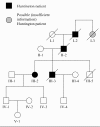Association of Huntington's disease and schizophrenia-like psychosis in a Huntington's disease pedigree
- PMID: 16480508
- PMCID: PMC1386660
- DOI: 10.1186/1745-0179-2-1
Association of Huntington's disease and schizophrenia-like psychosis in a Huntington's disease pedigree
Abstract
Background: Huntington's disease (HD) is a dominantly inherited, neurodegenerative disorder due to expansion of a polymorphic trinucleotide repeat in the short arm of chromosome 4. Clinical manifestations consist of a triad of choreic movements, cognitive decline and psychiatric syndromes starting in the fourth to fifth decade. Psychiatric manifestations vary and may precede motor and cognitive changes. Personality changes and depression occur most commonly. Paranoid schizophrenia-like symptoms occur in 6% to 25% of cases.
Case report: We describe a 55 year-old woman with an 8 yearlong history of behavioural changes, multi-thematic delusions and auditory hallucinations. History and mental state examination were suggestive of paranoid schizophrenia. Neurological examination revealed discrete, involuntary movements affecting her arms and trunk. Genotyping detected an expanded allele (43 trinucleotide repeats). A three-generation-long family history of chorea and schizophrenia-like psychosis was found.
Conclusion: HD-families have been reported in which schizophrenia-like syndromes emerged in all or most HD-affected members long before they developed extra-pyramidal or cognitive changes. This has been attributed to more than mere coincidence. We hypothesise that in these families the HD gene is transmitted along with a low load of small-effect "psychosis genes" which, in the presence of the severe cognitive changes of HD, manifest as a schizophrenia-like phenotype. Further research is needed in order to clarify the links between genetic loading and the emergence of psychotic symptoms in Huntington's disease.
Figures
References
-
- Watt DC, Seller A. A clinico-genetic study of psychiatric disorder in Huntington's chorea. Psychol Med Suppl. 1993;23:1–46. - PubMed
-
- Bolt J. Huntington's Chorea in the West of Scotland. Brit J Psychiat. 1970;116:259–270. - PubMed
-
- Kremer B, Goldberg P, Andrew SE, Theilmann J, Telenius H, Zeisler J, Squitieri F, Lin B, Bassett A, Almqvist E, Bird T, Hayden M. A Worldwide Study of the Huntington's Disease Mutation: the Sensitivity and Specificity of Measuring CAG Repeats. N Engl J Med. 1994;330:1401–1406. doi: 10.1056/NEJM199405193302001. - DOI - PubMed
-
- Andrew S, Goldberg Y, Kremer B, Telenius H, Theilmann J, Adam S, Starr E, Squitieri F, Lin B, Kalchman, Graham R, Hayden M. The relationship between trinucleotide (CAG) repeat length and clinical features of Huntington's disease. Nature Genetics. 1993;4:398–403. doi: 10.1038/ng0893-398. - DOI - PubMed
LinkOut - more resources
Full Text Sources


 /
/  –…
–… – Possible (insufficient information) Huntington patient.
– Possible (insufficient information) Huntington patient.